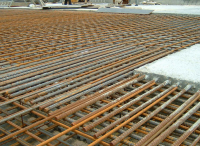


Reinforced concrete (RC) is a composite material in which concrete's relatively low tensile strength and ductility are counteracted by the inclusion of reinforcement having higher tensile strength and/or ductility. The reinforcement is usually, though not necessarily, steel reinforcing bars (rebar) and is usually embedded passively in the concrete before the concrete sets. Reinforcing schemes are generally designed to resist tensile stresses in particular regions of the concrete that might cause unacceptable cracking and/or structural failure. Modern reinforced concrete can contain varied reinforcing materials made of steel, polymers or alternate composite material in conjunction with rebar or not. Reinforced concrete may also be permanently stressed (in compression), so as to improve the behaviour of the final structure under working loads. In the United States, the most common methods of doing this are known as pre-tensioning and post-tensioning.
For a strong, ductile and durable construction the reinforcement needs to have the following properties at least:
High relative strength
High toleration of tensile strain
Good bond to the concrete, irrespective of pH, moisture, and similar factors
Thermal compatibility, not causing unacceptable stresses in response to changing temperatures.
Durability in the concrete environment, irrespective of corrosion or sustained stress for example.
History
François Coignet was a French industrialist of the nineteenth century, a pioneer in the development of structural, prefabricated and reinforced concrete.Coignet was the first to use iron-reinforced concrete as a technique for constructing building structures.In 1853 Coignet built the first iron reinforced concrete structure, a four story house at 72 rue Charles Michels in the suburbs of Paris.Coignet's descriptions of reinforcing concrete suggests that he did not do it for means of adding strength to the concrete but for keeping walls in monolithic construction from overturning.
Joseph Monier, a French gardener and known to be one of the principal inventors of reinforced concrete, was granted a patent for reinforced flowerpots by means of mixing a wire mesh to a mortar shell. In 1877, Monier was granted another patent for a more advanced technique of reinforcing concrete columns and girders with iron rods placed in a grid pattern. Though Monier undoubtedly knew reinforcing concrete would improve its inner cohesion, it is less known if he even knew how much reinforcing actually improved concrete's tensile strength.
Before 1877 the use of concrete construction, though dating back to the Roman Empire and reintroduced in the mid to late 1800s, was not yet a proven scientific technology. American New Yorker Thaddeus Hyatt published a report titled An Account of Some Experiments with Portland-Cement-Concrete Combined with Iron as a Building Material, with Reference to Economy of Metal in Construction and for Security against Fire in the Making of Roofs, Floors, and Walking Surfaces where he stated his experiments on the behavior of reinforced concrete. His work played a major role in the evolution of concrete construction as a proven and studied science. Without Hyatt's work, more dangerous trial and error methods would have largely been depended on for the advancement in the technology.
G. A. Wayss, was a German civil engineer and a pioneer of the iron and steel concrete construction. In 1879 Wayss bought the German rights to Monier's patents and in 1884 started the first commercial use for reinforced concrete in his firm Wayss & Freytag. Up until the 1890s Wayss and his firm greatly contributed to the advancement of Monier's system of reinforcing and established it as a well-developed scientific technology.
Ernest L. Ransome, was an English-born engineer and early innovator of the reinforced concrete techniques in the end of the 19th century. With the knowledge of reinforced concrete developed during the previous 50 years, Ransome innovated nearly all styles and techniques of the previous known inventors of reinforced concrete. Ransome's key innovation was to twist the reinforcing steel bar improving bonding with the concrete.
Gaining increasing fame from his concrete constructed buildings Ransome was able to build two of the first reinforced concrete bridges in North America.
Use in construction
Many different types of structures and components of structures can be built using reinforced concrete including slabs, walls, beams, columns, foundations, frames and more.
Reinforced concrete can be classified as precast or cast-in-place concrete.
Designing and implementing the most efficient floor system is key to creating optimal building structures. Small changes in the design of a floor system can have significant impact on material costs, construction schedule, ultimate strength, operating costs, occupancy levels and end use of a building.
Without reinforcement, constructing modern structures with concrete material would not be possible.